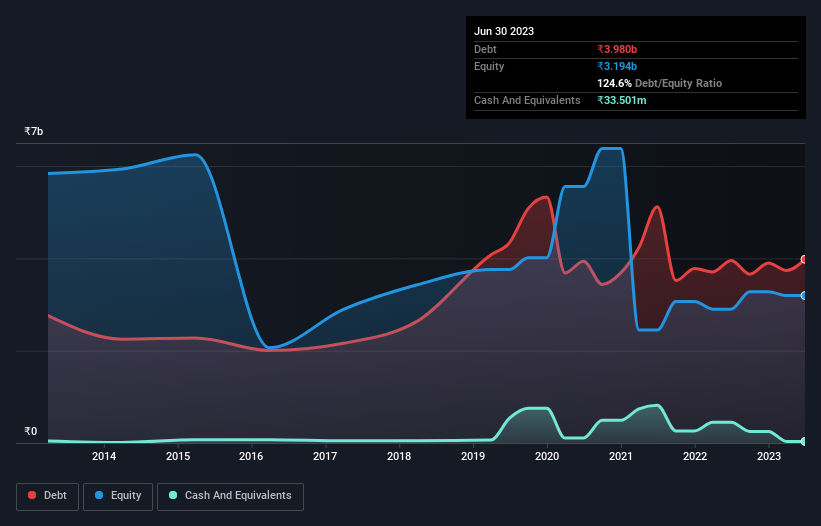- India
- /
- Household Products
- /
- NSEI:EVEREADY
Is Eveready Industries India (NSE:EVEREADY) A Risky Investment?

Warren Buffett famously said, 'Volatility is far from synonymous with risk.' It's only natural to consider a company's balance sheet when you examine how risky it is, since debt is often involved when a business collapses. We can see that Eveready Industries India Limited (NSE:EVEREADY) does use debt in its business. But the more important question is: how much risk is that debt creating?
What Risk Does Debt Bring?
Debt and other liabilities become risky for a business when it cannot easily fulfill those obligations, either with free cash flow or by raising capital at an attractive price. Part and parcel of capitalism is the process of 'creative destruction' where failed businesses are mercilessly liquidated by their bankers. However, a more common (but still painful) scenario is that it has to raise new equity capital at a low price, thus permanently diluting shareholders. Having said that, the most common situation is where a company manages its debt reasonably well - and to its own advantage. The first thing to do when considering how much debt a business uses is to look at its cash and debt together.
Check out our latest analysis for Eveready Industries India
What Is Eveready Industries India's Debt?
As you can see below, Eveready Industries India had ₹3.98b of debt, at March 2023, which is about the same as the year before. You can click the chart for greater detail. Net debt is about the same, since the it doesn't have much cash.

A Look At Eveready Industries India's Liabilities
The latest balance sheet data shows that Eveready Industries India had liabilities of ₹4.29b due within a year, and liabilities of ₹2.35b falling due after that. Offsetting these obligations, it had cash of ₹33.5m as well as receivables valued at ₹1.57b due within 12 months. So its liabilities outweigh the sum of its cash and (near-term) receivables by ₹5.03b.
Of course, Eveready Industries India has a market capitalization of ₹30.4b, so these liabilities are probably manageable. Having said that, it's clear that we should continue to monitor its balance sheet, lest it change for the worse.
We measure a company's debt load relative to its earnings power by looking at its net debt divided by its earnings before interest, tax, depreciation, and amortization (EBITDA) and by calculating how easily its earnings before interest and tax (EBIT) cover its interest expense (interest cover). This way, we consider both the absolute quantum of the debt, as well as the interest rates paid on it.
While Eveready Industries India's debt to EBITDA ratio (3.8) suggests that it uses some debt, its interest cover is very weak, at 1.7, suggesting high leverage. So shareholders should probably be aware that interest expenses appear to have really impacted the business lately. The good news is that Eveready Industries India improved its EBIT by 9.8% over the last twelve months, thus gradually reducing its debt levels relative to its earnings. There's no doubt that we learn most about debt from the balance sheet. But it is Eveready Industries India's earnings that will influence how the balance sheet holds up in the future. So if you're keen to discover more about its earnings, it might be worth checking out this graph of its long term earnings trend.
Finally, a business needs free cash flow to pay off debt; accounting profits just don't cut it. So it's worth checking how much of that EBIT is backed by free cash flow. During the last three years, Eveready Industries India produced sturdy free cash flow equating to 63% of its EBIT, about what we'd expect. This cold hard cash means it can reduce its debt when it wants to.
Our View
Eveready Industries India's interest cover was a real negative on this analysis, although the other factors we considered were considerably better. In particular, we thought its conversion of EBIT to free cash flow was a positive. Looking at all this data makes us feel a little cautious about Eveready Industries India's debt levels. While debt does have its upside in higher potential returns, we think shareholders should definitely consider how debt levels might make the stock more risky. When analysing debt levels, the balance sheet is the obvious place to start. However, not all investment risk resides within the balance sheet - far from it. We've identified 3 warning signs with Eveready Industries India (at least 2 which are concerning) , and understanding them should be part of your investment process.
If, after all that, you're more interested in a fast growing company with a rock-solid balance sheet, then check out our list of net cash growth stocks without delay.
Valuation is complex, but we're here to simplify it.
Discover if Eveready Industries India might be undervalued or overvalued with our detailed analysis, featuring fair value estimates, potential risks, dividends, insider trades, and its financial condition.
Access Free AnalysisHave feedback on this article? Concerned about the content? Get in touch with us directly. Alternatively, email editorial-team (at) simplywallst.com.
This article by Simply Wall St is general in nature. We provide commentary based on historical data and analyst forecasts only using an unbiased methodology and our articles are not intended to be financial advice. It does not constitute a recommendation to buy or sell any stock, and does not take account of your objectives, or your financial situation. We aim to bring you long-term focused analysis driven by fundamental data. Note that our analysis may not factor in the latest price-sensitive company announcements or qualitative material. Simply Wall St has no position in any stocks mentioned.
About NSEI:EVEREADY
Eveready Industries India
Manufactures and markets dry cell batteries, flashlights, and lighting and electrical products in India and internationally.
Solid track record with excellent balance sheet and pays a dividend.
Similar Companies
Market Insights
Community Narratives



